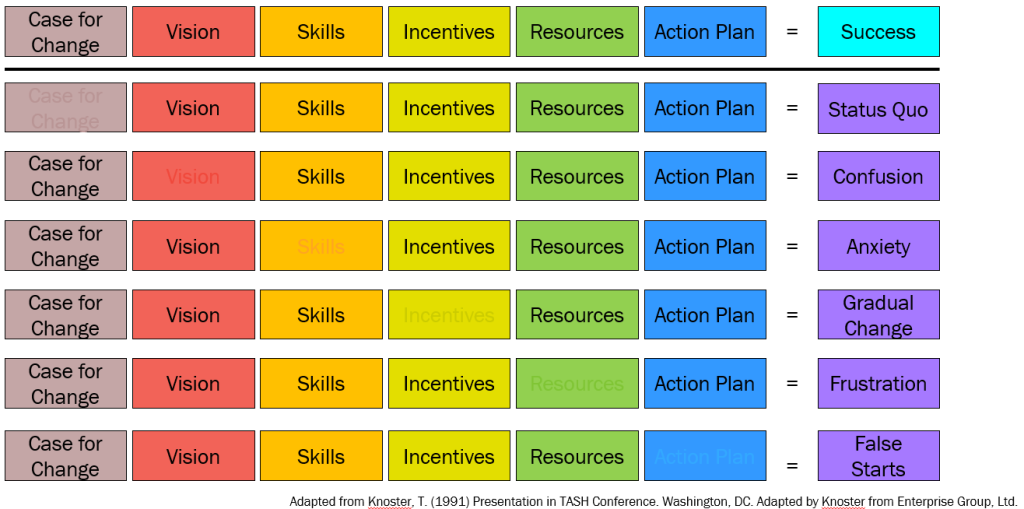
For many years, I struggled. My projects would start off strong. But, at some point, they would stall before the finish line. Some projects would never really get off the starting block while others would seem to take steps forward and then back.
Then, one day, I began taking a different approach. And, every time since, my projects would make steady progress forward. Many years later, I had the opportunity to share this approach with an entire team of commercial business leaders who then took on the approach. Each and every one of them completed their initiatives successfully and on-time. In this article, I am going to pass this secret along to you.
In a nutshell, taking action to address the Dimensions of Complex Change will help you to achieve success anytime you are looking to accomplish something new – even in the most challenging situations. Refer to the figure below. In order for change to successfully occur, all six dimensions must be accounted for. If a dimension is missing, the team will experience one or more of the failure modes shown in purple. So, how does this work in practice? This article covers what types of actions to taken to meet these hurdles.

1. Case for Change
Consider the case of a fictitious company that we call BeverageManufacturingCorp in Granville. This newly launched company sold mango flavored bottled soft drinks. Then, one day, the package designer suggested that they could supply the bottles in orange rather than the traditional clear plastic for no additional cost. Should BeverageManufacturingCorp make the change? Even though the new bottles were the same cost, the company decided to keep the bottles as they were? Why? Because the new bottles were unlikely to attract more business resulting in a weak case for change.
Now, consider a time when you tried to motivate a team to get behind a change that the team could do but nothing happened. The lesson to learn here is that, there has to be a strong, clear, and compelling case for change. Not only this, it needs to be expressed in a language that is compelling to those who need to approve and to implement it. Otherwise, the team will not take action.
2. Vision
Returning to our fictitious manufacturing company, the company now has decided to enter the lemonade manufacturing business due to low drinking water sales. The site manager made sure that everyone knew what was at stake. They ordered equipment. And, they even assembled a team to help get things done. But, the work stagnated. The equipment sat unused as the team argued about the plans. What happened? The site leader had failed to explain his vision.
This is an often overlooked step. It's not enough to explain the reason why as in the case for change. And, moving on to detailed planning without a clear understanding of what needs to be accomplished is another pitfall. To avoid confusion, it is essential to provide a vision of the end goal.
3. Skills
In the previous example, we considered a case where experts knew what to do when provided with a clear explanation of what you are looking to accomplish. But, what if this is not the case?
Let's say for example, BeverageManufacturingCorp knew how to package mango drinks but had no experience in mass producing lemonade. Given the stakes involved, the team is likely to be anxious and not step up to do work that they are unfamiliar with. How should this be addressed?
In order to successfully make a change that is new to the company or its employees, careful consideration should be given to the knowledge and skills that are needed to complete the task. And measures, such as hiring, training, or recruiting qualified resources to help out, should be part of the change management process to successfully make a change.
4. Incentives
In today's business climate where everyone is busy, it is not hard to see that a lack of incentives may result in highly capable teams making very little progress. The question is, how do you incentivize people to work on your project instead of other things that they could be doing? One approach is to give monetary incentives. But, paying a salaried person to do their jobs is not likely to work out. You could potentially resort to threats and ultimatums, but this is far from an ideal way to motivate team members and colleagues.
In my experience, I have found 3 ways to incentivize teammates to work on specific projects.
- The first incentive is that a successful completion of the project benefits them in some way. This incentive could be a project who's outcome furthers their agenda. Or it could be that the project has a fantastic business case and would reflect well for those on the team to have been involved in.
- A second incentive is visibility. If senior leaders will be present and involved, for example, it is likely that team members will recognize this project as a priority and strive to make progress before the next big meeting.
- A third incentive is that the request is very easy and straightforward to do or the leader is known to have a solid plan that will end well. Most of us don't mind spending time here and there doing work that's not a big deal. And most of us don't mind being part of something bigger and likely to be successful.
By tapping into intrinsic and extrinsic motivations, you will be much more likely to speed up a traditionally slow process into one what moves forward with a greater sense of urgency.
5. Resources
Similar to the above, it is not uncommon for one of the first requests to be “We need more resources.” when tasked with a new project. And, if you team members feel overwhelmed by work that is already on their plate, they may feel frustrated by the demands on their time. So, how do you obtain the resources needed for your project? Practically speaking, companies tend not to staff up for each initiative. Instead, the responsibilities are distributed to make the increase in workload manageable, the scope of the project is minimized and focused, and work that can be standardized or outsourced are removed from the project.
6. Action Plan
Consider a time when you make a New Year's resolution to lose weight. Did you accomplish this goal? In this case, your case for change might have been being healthier. You had a vision of the skinnier you. You may have even signed up for a gym membership. But, if you're like most, you will stop your healthy new habits within a month. And, by the next New Year, you will be ready to begin again. So, what causes false starts? A common cause of starting-stopping-starting again is the lack of an action plan. If you began the new year with a detailed action plan consisting of what exercises you would do, what diet you would eat, and when to go buy what groceries, for example, you have better odds of success than someone who has a resolution but not a plan.
Summary
In summary, taking action to address the Dimensions of Complex Change will help you to achieve success – even in the most challenging situations. In order for change to successfully occur, all six dimensions must be accounted for. Involving the team in helping to address these considerations upfront will help team members (and senior leaders alike) ensure that the right steps are being taken to assure the team's success.
The concepts in this article are backed by tools and methods for implementation. If you are interested in implementing the Dimensions of Complex Change within your organization, please reach out to Felicia Littlejohn for a discovery conversation.
About the Author
Felicia Littlejohn, Ph.D., is Learning and Development (L&D) professional, leadership coach, and former commercial business leader who empowers others to achieve their goals. Her work in leadership development, coaching, and strategy consulting has helped businesses, teams, and professionals to upskill, cultivate leadership potential, enhance performance, and overcome growth hurdles. Felicia is a Certified Professional Coach (C.P.C.) who holds a Ph.D. in Engineering, an M.B.A. in Marketing, and is currently pursuing an M.Ed. in Instructional Design.